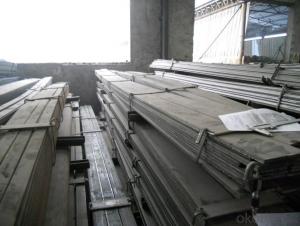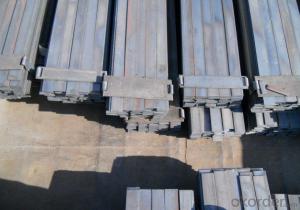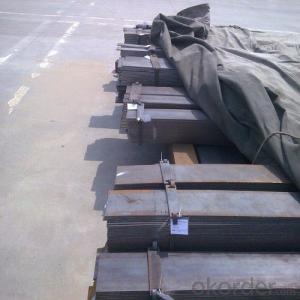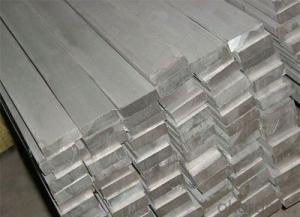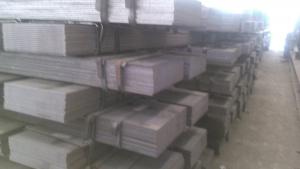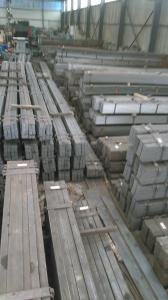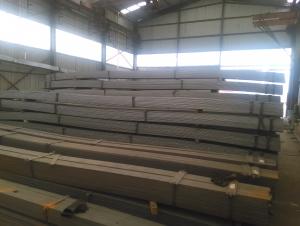Steel Flat Bar Chinese Standard Slit and Cut Form
- Loading Port:
- China main port
- Payment Terms:
- TT or LC
- Min Order Qty:
- 25 m.t.
- Supply Capability:
- 10000 m.t./month
OKorder Service Pledge
OKorder Financial Service
You Might Also Like
1. Structure of Steel Flat Bar Chinese Standard Slit and Cut Form Description:
Steel flat bar Chinese standard slit and cut form is a beam with an I-shaped cross-section. The horizontal elements of the "I" are known as flanges, while the vertical element is termed the "web". Steel flat bar Chinese standard slit and cut form is usually made of structural steel and is used in construction and civil engineering. The steel flat bar Chinese standard slit and cut form resists shear forces, while the flanges resist most of the bending moment experienced by the beam. Steel flat bar Chinese standard slit and cut form theory shows that the I-shaped section is a very efficient form for carrying both bending and shears loads in the plane of the web.
2. Main Features of Steel Flat Bar Chinese Standard Slit and Cut Form:
• Grade: Q235
• Type: Mild carbon steel
• Deflection: The stiffness of the I-beam will be chosen to minimize deformation
• Vibration: The stiffness and mass are chosen to prevent unacceptable vibrations, particularly in settings sensitive to vibrations, such as offices and libraries.
• Local yield: Caused by concentrated loads, such as at the beam's point of support.
3. Steel Flat Bar Chinese Standard Slit and Cut Form Images:
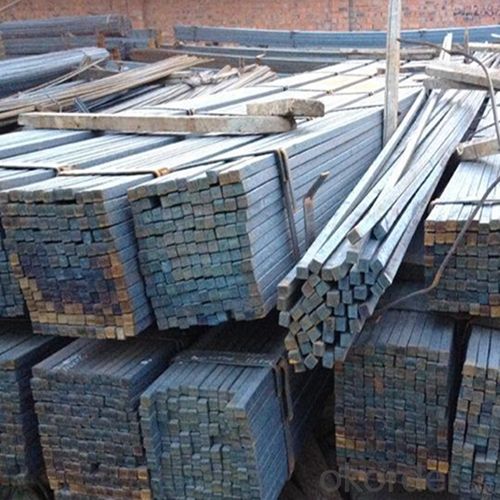
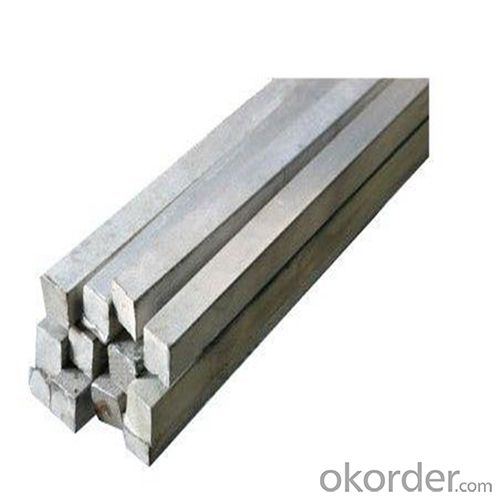
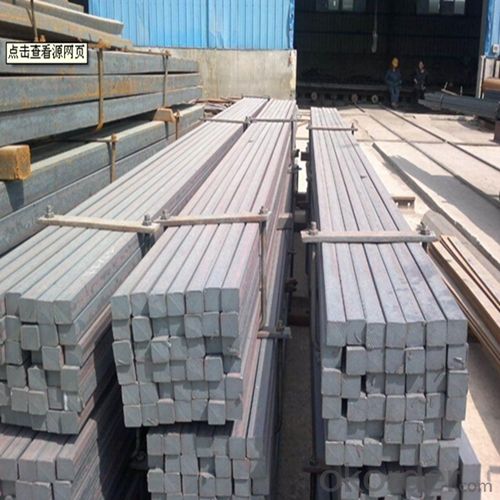
4. Steel Flat Bar Chinese Standard Slit and Cut Form Specification:
Alloy No | Grade | Element(%) | ||||
C
| Mn
| S
| P
| Si
| ||
Q235
|
B
|
0.12—0.20 |
0.3—0.7 |
≤0.045 |
≤0.045
|
≤0.3
|
Alloy No | Grade | Yielding strength point(Mpa) | Tensile strength (Mpa) | Elongation after fracture(%) | ||||||
Thickness (mm) | Thickness (mm) | |||||||||
≤16 | >16--40 | >40--60 | >60--100 | ≤16 | >16--40 | >40--60 | >60--100 | |||
≥ | ≥ | |||||||||
Q235 |
B |
235 |
225 |
215 |
205 |
375--500 |
26 |
25 |
24 |
23 |
5. FAQ
We have organized several common questions for our clients,may help you sincerely:
①Is this product same as W beam?
In the United States, the most commonly mentioned I-beam is the wide-flange (W) shape. These beams have flanges in which the planes are nearly parallel. Other I-beams include American Standard (designated S) shapes, in which flange surfaces are not parallel, and H-piles (designated HP), which are typically used as pile foundations. Wide-flange shapes are available in grade ASTM A992,[4] which has generally replaced the older ASTM grades A572 and A36.
②How to inspect the quality?
We have a professional inspection group which belongs to our company. We resolutely put an end to unqualified products flowing into the market. At the same time, we will provide necessary follow-up service assurance.
③Is there any advantage about this kind of product?
Steel I beam bar IPE has a reduced capacity in the transverse direction, and is also inefficient in carrying torsion, for which hollow structural sections are often preferred.
- Q:Are steel flat bars used in the manufacturing of medical equipment or devices?
- Yes, steel flat bars are commonly used in the manufacturing of medical equipment or devices. Steel is known for its strength, durability, and resistance to corrosion, making it an ideal material for various medical applications. Steel flat bars are often used to create structural components, supports, frames, and brackets for medical devices. These bars provide stability and support, ensuring the safe and efficient functioning of the equipment. Additionally, steel can be easily sterilized, making it suitable for use in sterile environments such as hospitals and clinics. Overall, steel flat bars play a crucial role in the manufacturing of medical equipment and devices, contributing to their reliability and longevity.
- Q:How are steel flat bars manufactured?
- Steel flat bars undergo a process called hot rolling to be manufactured. This process entails heating a steel billet or ingot above its recrystallization temperature, usually around 1,000 to 1,300 degrees Celsius. The heated steel is then passed through a series of rollers to gradually decrease its thickness and shape it into a flat bar. In the hot rolling process, the steel is initially descaled to eliminate any surface impurities and oxides. It then goes through a roughing mill, which consists of multiple sets of large rollers that progressively reduce the steel's thickness. The steel is continuously reheated and passed through the rollers until it reaches the desired thickness. Once the steel has reached the desired thickness through roughing, it moves on to a finishing mill. This mill features smaller rollers that further decrease the thickness of the steel and enhance its surface finish. The steel is rolled back and forth between these rollers until it reaches its final thickness, typically ranging from 3 to 25 millimeters. After the final rolling, the steel flat bar is cooled using water or air to temper it and improve its mechanical properties. It is then cut to the desired length and may undergo additional processes like straightening or surface treatments, depending on its intended use. In summary, the manufacturing process of steel flat bars involves hot rolling, which encompasses descaling, roughing, finishing, cooling, and final processing stages to produce flat bars with various thicknesses and lengths.
- Q:Can steel flat bars be used for elevator shafts or doors?
- Yes, steel flat bars can be used for elevator shafts or doors. Steel flat bars are commonly used in construction and fabrication projects due to their strength and durability. Elevator shafts and doors require materials that can withstand heavy loads, provide structural integrity, and ensure safety for passengers. Steel flat bars possess these qualities and are often used in the construction of elevator shafts and doors. They can be fabricated and welded to create the necessary framework and provide the necessary support for elevator systems. Additionally, steel flat bars can be coated or treated to enhance their corrosion resistance, making them suitable for both interior and exterior elevator applications.
- Q:How do steel flat bars perform under load?
- Steel flat bars are known for their exceptional strength and durability, making them highly reliable under load. When subjected to a load, such as weight or pressure, steel flat bars are able to distribute and bear the load evenly across their entire surface. This is due to their flat and wide shape, which provides a larger contact area compared to other types of bars. Under load, steel flat bars exhibit minimal deflection or bending. This is because steel is a rigid material with high tensile and compressive strength, allowing it to withstand heavy loads without permanent deformation. Additionally, the flat shape of the bar helps to distribute the load along its length, preventing localized stress concentrations that could lead to failure. Steel flat bars also have excellent load-bearing capacity, meaning they can support heavy loads without breaking or collapsing. This is especially important in structural applications where the bars are used as beams or supports. Steel's high strength-to-weight ratio allows for the construction of lightweight structures that can withstand substantial loads. Furthermore, steel flat bars have good resistance to fatigue and creep, which are common failure mechanisms under prolonged or cyclic loading. This makes them suitable for applications where constant or repetitive loading is expected, such as in bridges, buildings, or machinery. In summary, steel flat bars perform exceptionally well under load. Their strength, rigidity, and load-bearing capacity make them a reliable choice for various applications requiring structural support or the ability to withstand heavy loads.
- Q:How do steel flat bars contribute to the overall stability of structures?
- Steel flat bars contribute to the overall stability of structures in several ways. Firstly, they provide structural support and reinforcement, helping to distribute and transfer loads. Due to their flat shape, they can be easily attached to other structural components such as beams and columns, increasing the overall strength and stability of the structure. Furthermore, steel flat bars offer high tensile strength, making them resistant to bending and breaking under heavy loads or external forces. This strength allows them to effectively resist deformation and maintain the structural integrity of the building. Steel flat bars also play a crucial role in preventing lateral movement and buckling. By being strategically placed and connected to other structural elements, they help to resist horizontal forces such as wind or seismic loads, ensuring the stability and safety of the structure during extreme events. Moreover, steel flat bars can be used as bracing elements, providing additional stiffness to the structure. By installing them diagonally or horizontally, they enhance the overall rigidity of the building, reducing the potential for excessive deflection or sway. Additionally, steel flat bars have excellent durability and corrosion resistance properties. This ensures that they can withstand harsh environmental conditions, including moisture and temperature fluctuations, without compromising their strength or stability. Their longevity contributes to the overall stability and longevity of the structure. In summary, steel flat bars contribute to the overall stability of structures by providing structural support, distributing and transferring loads, resisting deformation and lateral movement, enhancing rigidity, and offering durability and corrosion resistance. Their versatile and robust nature makes them an essential component in various construction applications, ensuring the safety and stability of buildings and infrastructure.
- Q:Can steel flat bars be used for making gates or fences?
- Yes, steel flat bars can be used for making gates or fences. Steel flat bars are commonly used in gate and fence construction due to their strength, durability, and versatility. They provide a sturdy framework and can be easily welded or bolted together to create a secure and long-lasting structure. Additionally, steel flat bars can be customized to fit different gate or fence designs, making them an ideal choice for this purpose.
- Q:Are steel flat bars prone to corrosion?
- Yes, steel flat bars are prone to corrosion, especially when exposed to moisture and oxygen.
- Q:How do you protect steel flat bars from chemical exposure?
- To protect steel flat bars from chemical exposure, there are several measures you can take. 1. Coating: Applying a protective coating is one of the most effective ways to shield steel flat bars from chemical exposure. There are various types of coatings available, such as epoxy, polyurethane, or zinc-based coatings, that can provide a barrier between the steel and the chemicals. These coatings should be carefully selected based on the specific chemicals the steel will be exposed to and their compatibility with the coating material. 2. Galvanization: Galvanizing the steel flat bars can offer excellent protection against chemical exposure. This process involves coating the steel with a layer of zinc, which acts as a sacrificial barrier. When the steel comes into contact with chemicals, the zinc coating corrodes instead of the steel, preventing direct chemical attack. 3. Stainless steel: Using stainless steel flat bars, particularly those made from corrosion-resistant grades such as 316 or 304, can provide excellent resistance to chemical exposure. Stainless steel contains a minimum of 10.5% chromium, which forms a protective oxide layer on its surface, preventing corrosion by most chemicals. 4. Proper storage: Storing steel flat bars in a controlled environment can help minimize chemical exposure. Ideally, the storage area should be dry, well-ventilated, and free from any direct contact with corrosive substances. Additionally, proper stacking and separation of different materials can prevent chemical reactions and potential damage. 5. Regular maintenance: Regular inspection and maintenance are essential to ensure the continued protection of steel flat bars from chemical exposure. Any signs of coating damage or corrosion should be addressed promptly. Cleaning the surface using appropriate methods and products can help remove any chemical residues and maintain the integrity of the protective measures. It is important to note that the specific protective measures will depend on the type and concentration of chemicals the steel flat bars will be exposed to. Therefore, consulting with corrosion and material experts or referring to industry standards and guidelines can provide more tailored recommendations for protecting steel flat bars in a specific chemical environment.
- Q:What are the different cutting methods for steel flat bars?
- There are several cutting methods for steel flat bars, including sawing, shearing, and plasma cutting. Sawing involves using a saw blade to cut through the bar, while shearing uses a shearing machine to trim the material. Plasma cutting, on the other hand, involves using a high-temperature plasma torch to melt and separate the steel. Each method has its own advantages and is suitable for different applications and requirements.
1. Manufacturer Overview |
|
|---|---|
| Location | |
| Year Established | |
| Annual Output Value | |
| Main Markets | |
| Company Certifications | |
2. Manufacturer Certificates |
|
|---|---|
| a) Certification Name | |
| Range | |
| Reference | |
| Validity Period | |
3. Manufacturer Capability |
|
|---|---|
| a)Trade Capacity | |
| Nearest Port | |
| Export Percentage | |
| No.of Employees in Trade Department | |
| Language Spoken: | |
| b)Factory Information | |
| Factory Size: | |
| No. of Production Lines | |
| Contract Manufacturing | |
| Product Price Range | |
Send your message to us
Steel Flat Bar Chinese Standard Slit and Cut Form
- Loading Port:
- China main port
- Payment Terms:
- TT or LC
- Min Order Qty:
- 25 m.t.
- Supply Capability:
- 10000 m.t./month
OKorder Service Pledge
OKorder Financial Service
Similar products
New products
Hot products
Hot Searches
Related keywords






